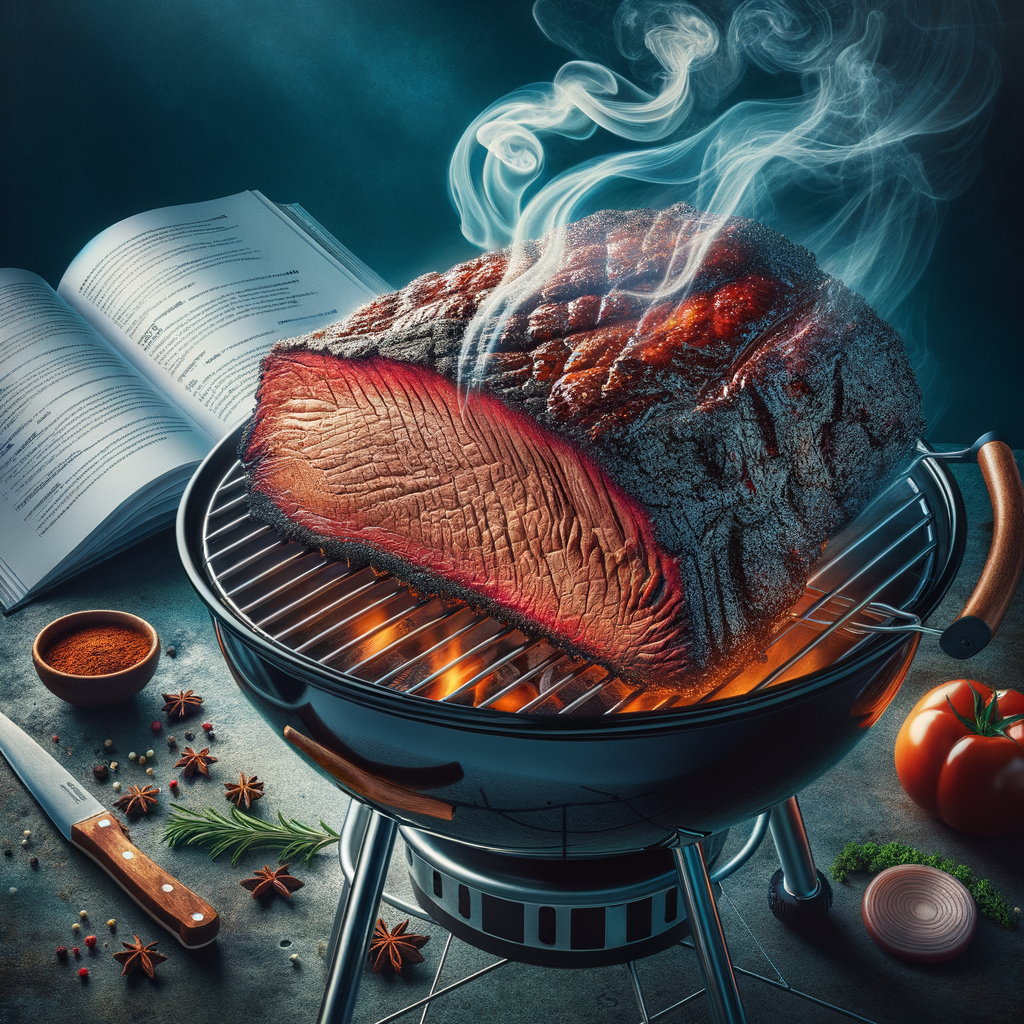
Introduction to Smoked Brisket Recipe
Welcome to the world of smoked brisket! This delicious and tender meat dish is a favorite at BBQs and family gatherings. In this blog post, we will explore the basics of smoked brisket and why it’s a BBQ favorite.
- Understanding the basics of smoked brisket
- Why smoked brisket is a BBQ favorite
Smoked brisket is a dish made from the brisket cut of beef or veal. The brisket is one of the nine primal cuts of beef and is located near the chest of the animal. This cut of meat is known for its rich flavor and tender texture when cooked properly. The process of smoking the brisket involves slow cooking it over low heat, usually with wood chips for added flavor. This slow cooking process allows the fat in the brisket to melt and tenderize the meat, resulting in a juicy and flavorful dish.
Smoked brisket is a BBQ favorite for many reasons. First, the slow cooking process used to smoke the brisket brings out the rich flavors of the meat, making it a delicious main dish. Second, the smoking process gives the brisket a unique smoky flavor that is hard to resist. Finally, smoked brisket is versatile and can be served in a variety of ways, including on its own, in sandwiches, or as part of a BBQ platter. These factors combined make smoked brisket a beloved choice at BBQs.
In the following sections, we will delve deeper into the process of smoking a brisket, including a step-by-step guide, smoking techniques, post-smoking steps, troubleshooting common problems, and tips and tricks to help you master your smoked brisket recipe. Stay tuned!
The Ultimate Smoked Brisket Guide
When it comes to smoking brisket, the journey begins long before you light up your smoker. It starts with choosing the perfect brisket. In this guide, we will walk you through the process of selecting the best brisket for smoking.
Choosing the Perfect Brisket
Choosing the right brisket is the first step towards a delicious smoked brisket. Here are some key factors to consider:
- What to look for when buying brisket: When buying a brisket, look for one that is uniform in thickness and has a thick layer of fat on one side, known as the fat cap. This fat will melt during the smoking process, keeping the meat moist and flavorful. The brisket should also have good marbling, which are the thin veins of fat running through the meat. This will also contribute to the flavor and tenderness of the smoked brisket.
- Choosing between a flat cut and a point cut: A brisket is made up of two parts – the flat cut and the point cut. The flat cut, also known as the first cut, is leaner and has a more uniform shape, making it easier to slice. The point cut, also known as the second cut, has more fat and is more flavorful. For smoking, many experts recommend using the whole brisket, which includes both cuts, to get the best of both worlds. However, if you have to choose, the point cut may be a better option for smoking due to its higher fat content.
Remember, a good brisket is the foundation of a great smoked brisket. So, take your time and choose wisely. Happy smoking!
Preparation for Low and Slow Brisket
Before you can start smoking your brisket, there are a few key steps you need to take to ensure the best possible result. These steps are crucial in achieving a tender, flavorful brisket that is cooked low and slow to perfection.
- Trimming the Brisket
- Applying the Rub
- Preheating the Smoker
Trimming the brisket is the first step in the preparation process. This involves removing the excess fat and silver skin from the brisket. While some fat is good as it melts during cooking and adds flavor, too much can prevent the smoke and rub from penetrating the meat. Aim to leave about 1/4 inch of fat on the brisket.
Once the brisket is trimmed, it’s time to apply the rub. The rub is a mixture of spices that adds flavor to the brisket. It’s important to apply the rub generously and evenly, covering all sides of the brisket. This will create a delicious crust on the brisket as it smokes.
The final step in preparing your brisket for smoking is preheating the smoker. This is crucial because it ensures that the brisket starts cooking as soon as it’s placed in the smoker. Aim for a temperature of 225-250 degrees Fahrenheit for low and slow cooking. This low temperature allows the brisket to cook slowly, breaking down the tough connective tissue and resulting in a tender, juicy brisket.
By following these steps, you’ll be well on your way to creating a smoked brisket that’s tender, flavorful, and cooked to perfection. Remember, the key to a great smoked brisket is patience and preparation.
Tender Smoked Brisket: Smoking Techniques
Smoking a brisket to perfection requires a good understanding of the smoking process. Let’s delve into the key elements that can make or break your smoked brisket.
Understanding the Smoking Process
When it comes to smoking a brisket, two crucial factors come into play: maintaining a consistent temperature and using wood chips for flavor. Let’s explore these aspects in detail.
- The importance of maintaining a consistent temperature
- How to use wood chips for flavor
Keeping a steady temperature is vital for smoking a brisket. If the temperature fluctuates too much, it can lead to uneven cooking. The perfect temperature range for smoking a brisket is between 225°F and 250°F. This low and slow cooking process allows the heat to penetrate the meat evenly, breaking down the tough connective tissues and resulting in a tender, juicy brisket.
Wood chips are a fantastic way to infuse your brisket with a smoky flavor. Different types of wood chips can impart different flavors. For instance, hickory wood chips give a strong and hearty flavor, while applewood chips offer a milder, sweeter taste. To use wood chips, soak them in water for about 30 minutes before placing them on the coals. The soaked chips will smolder rather than burn, producing smoke that flavors the brisket.
Understanding and mastering these smoking techniques will ensure your brisket is tender, flavorful, and cooked to perfection. Remember, patience is key when smoking a brisket. The low and slow process might take time, but the end result is worth the wait.
BBQ Smoked Brisket: Cooking Time
One of the most crucial aspects of smoking a brisket is understanding the cooking time. The cooking time can vary based on several factors, including the size of the brisket and the temperature of the smoker. Here, we will discuss how to estimate cooking time and how to tell when your brisket is done.
- Estimating cooking time based on brisket size
- How to tell when your brisket is done
Generally, the rule of thumb for smoking a brisket is to allow between 1.5 to 2 hours of cooking time for each pound of meat at 225 degrees Fahrenheit. However, this can vary based on the specific cut of your brisket and the consistency of your smoker’s temperature.
For example, a 10-pound brisket could take anywhere from 15 to 20 hours to smoke. It’s important to remember that this is just an estimate, and the actual cooking time could be shorter or longer.
| Brisket Size (Pounds) | Estimated Cooking Time (Hours) |
|---|---|
| 5 | 7.5 – 10 |
| 10 | 15 – 20 |
| 15 | 22.5 – 30 |
While cooking time estimates can be helpful, the best way to tell if your brisket is done is by checking the internal temperature. The ideal internal temperature for a smoked brisket is between 195 and 205 degrees Fahrenheit.
Using a meat thermometer, insert it into the thickest part of the brisket. If it reads within this range, your brisket is done. Remember, the brisket should feel tender but not fall apart. If it’s too tough, it needs more time. If it’s falling apart, it may be overcooked.
Understanding the cooking time for your BBQ smoked brisket is key to achieving a tender, flavorful result. By estimating the cooking time based on the size of your brisket and checking the internal temperature, you can ensure your brisket is cooked to perfection.
How to Smoke Brisket: Post-Smoking Steps
After you’ve spent hours smoking your brisket, it’s time to move on to the post-smoking steps. These steps are just as important as the smoking process itself. They involve resting and slicing your brisket to perfection. Let’s dive into these steps and understand why they are crucial.
Resting and Slicing Your Brisket
Once your brisket is smoked, it’s not ready to be served just yet. There are a couple of steps you need to follow to ensure your brisket is tender, juicy, and delicious. These steps are resting and slicing your brisket.
- Why resting your brisket is crucial for tenderness
- How to properly slice a brisket
Resting your brisket is a step that should not be skipped. When you allow your brisket to rest, it reabsorbs the juices that have been pushed to the surface during the smoking process. This makes your brisket more tender and flavorful. It’s recommended to rest your brisket for at least an hour before slicing it.
Slicing your brisket properly is just as important as smoking and resting it. When you slice your brisket, make sure to cut against the grain. This will make your brisket more tender and easier to chew. Also, make sure your knife is sharp. A dull knife can shred the meat and make it less appealing.
In conclusion, the post-smoking steps of resting and slicing your brisket are crucial for a tender and flavorful brisket. By following these steps, you’ll be sure to impress your friends and family with your smoked brisket skills.
Brisket Smoking Guide: Troubleshooting Common Problems
Even the most experienced brisket smokers can encounter problems from time to time. But don’t worry, we’re here to help you troubleshoot and resolve these issues. Let’s dive into some of the most common problems and their solutions.
Addressing Common Smoking Issues
Here are some of the most common issues you might face when smoking a brisket, along with tips on how to fix them:
- What to do if your brisket is too dry
- How to fix a tough brisket
If your brisket turns out too dry, it’s likely because it was cooked at too high a temperature or for too long. To fix this, try lowering the temperature and monitoring the cooking time closely. You can also wrap your brisket in foil after it reaches an internal temperature of 150 degrees Fahrenheit. This will help keep the moisture in and prevent your brisket from drying out.
A tough brisket is usually a result of not cooking it long enough. Brisket needs to be cooked low and slow to break down the tough connective tissues. If your brisket is tough, try increasing the cooking time. Another tip is to let your brisket rest for at least an hour after cooking. This allows the juices to redistribute throughout the meat, making it more tender.
Remember, practice makes perfect. Don’t be discouraged if your first few attempts don’t turn out as expected. Keep trying, and with time, you’ll be able to smoke a perfect brisket.
Smoked Brisket Tips and Tricks
Mastering the art of smoking brisket can be a challenge, but with the right tips and tricks, you can achieve a perfect smoked brisket every time. Here are some expert advice to help you on your journey.
Expert Advice for Perfect Smoked Brisket
When it comes to smoking brisket, the flavor and tenderness of the meat are paramount. The right wood chips and the correct smoking technique can make all the difference. Let’s dive into these aspects in more detail.
- Favorite wood chip flavors for brisket
- Tips for achieving a smoky flavor without overpowering the meat
- Don’t overdo it with the wood chips. A handful or two is usually enough for a brisket.
- Ensure your smoker maintains a consistent temperature. Fluctuations can lead to over-smoking.
- Wrap your brisket in foil after a few hours of smoking. This will help to lock in the juices and prevent the meat from absorbing too much smoke.
The choice of wood chips can significantly influence the flavor of your smoked brisket. Hickory and oak are popular choices due to their strong and robust flavors. However, if you prefer a milder, sweeter flavor, apple or cherry wood chips are excellent options. Experiment with different wood chips to find your personal favorite.
While a smoky flavor is desired in a smoked brisket, it’s important not to overpower the natural flavor of the meat. Here are a few tips:
Remember, practice makes perfect. Don’t be discouraged if your first few attempts don’t turn out as expected. With these tips and tricks, you’ll be well on your way to mastering the art of smoked brisket.
Conclusion: Mastering Your Smoked Brisket Recipe
As we wrap up our comprehensive guide on smoking brisket, let’s take a moment to reflect on the key points we’ve covered and look forward to the delicious possibilities that await you.
- Recap of the ultimate smoked brisket guide: We started by introducing you to the art of smoking brisket, then delved into the ultimate smoked brisket guide where we discussed the importance of selecting the right cut of meat, preparing it with the right blend of spices, and the crucial role of temperature control. We also covered various smoking techniques to achieve that tender, melt-in-your-mouth texture. Post-smoking steps were also discussed to ensure your brisket remains juicy and flavorful. Lastly, we shared some tips and tricks and addressed common problems you might encounter during the smoking process.
- Encouragement to experiment and perfect your own brisket smoking techniques: Remember, the journey to mastering your smoked brisket recipe is one of experimentation and patience. Don’t be afraid to try different spice blends, wood types for smoking, or even different cuts of brisket. Each attempt brings you one step closer to perfecting your own signature smoked brisket recipe. As Thomas Edison famously said, “I have not failed. I’ve just found 10,000 ways that won’t work.” So, keep experimenting, keep learning, and most importantly, keep smoking those briskets!
In conclusion, smoking brisket is an art that requires time, patience, and practice. But with the knowledge you’ve gained from this guide, you’re well on your way to becoming a master. So go ahead, fire up that smoker and let’s get cooking!






